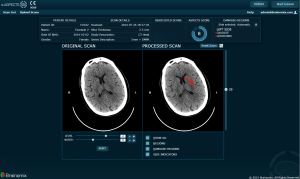Brainomix launches revolutionary e-ASPECTS software designed to improve outcomes for stroke patients

13th April 2015
Breakthrough technology automates analysis of CT brain scans to support doctors in making life-saving treatment decisions
Brainomix Limited, a developer of automated medical imaging software for neurological and cerebrovascular disorders, today announced the upcoming European launch of e-ASPECTS, a clinical decision-making support software designed for use with stroke patients. The University of Oxford start-up company received the CE mark for their e-ASPECTS software in March 2015, enabling the ground-breaking technology to be launched across Europe.
Brainomix will be launching the e-ASPECTS software at the European Stroke Organisation Conference in Glasgow between 17th and 19th April, 2015.
“Our aim was to improve stroke treatment and patient outcomes by developing software that gives all hospitals access to fast and reliable diagnoses, and I am delighted that we are now able to make this clinically tested technology available,” said Dr Michalis Papadakis, Brainomix Chief Executive Officer.
e-ASPECTS puts the expertise of the best stroke physicians into the hands of frontline medical staff. The e-ASPECTS software automatically implements the Alberta Stroke Program Early CT Score (ASPECTS) scoring system on brain images from acute ischaemic stroke patients to identify and quantify signs of early stroke damage and provide an assessment to support treatment decisions. Clinical trials have shown that e-ASPECTS is at least as good as expert physicians at identifying ischaemic changes in stroke patient brain CT scans and at applying the ASPECTS method.1
“The use of e-ASPECTS software means that medical professionals working with stroke patients receive a standardised and reliable interpretation of the patient’s brain CT scan, irrespective of their experience or expertise. This allows them to make a rapid and accurate assessment of ischaemic stroke damage so they can make an informed treatment decision as early as possible and ultimately optimise patient outcomes,” said Professor Jochen Fiebach, Head of Academic Neuroradiology at the Center for Stroke Research Berlin in Charité University Hospital.
The original ASPECTS method was invented by Professor Alastair Buchan, a co-founder of Brainomix and the Dean of Medicine and Professor of Stroke Medicine at the University of Oxford. The new e-ASPECTS software has been developed to assist stroke clinicians worldwide and to optimise the treatment of patients with acute stroke. This applies to both life-saving clot busting therapy (thrombolysis) and endovascular clot removal procedures. It can be used by hospitals offering a stroke service and in stroke clinical trials, providing major benefits to patients and healthcare systems.
The e-ASPECTS software runs on a server and uses a standard web browser interface, making is easily accessible by clinicians from many devices. As well as showing the ASPECTS scored images, e-ASPECTS presents the original image, making it easy for clinicians to fit this technique onto their workflow. It has been developed in, and with support from, the Isis Software Incubator, which is part of Oxford University Innovation Ltd, the technology commercialisation company of the University of Oxford.
Brainomix already have commitment from hospitals in the UK, Germany and Finland to use the new technology and are aiming to secure approval in the USA by the end of 2016.
Please visit the Brainomix booth at the European Stroke Organisation Conference in Glasgow between 17th and 19th April, 2015 (booth number: 08E).
References
1 Data on file
For further information about the e-ASPECTS software visit www.brainomix.com.
Media contact : Archana Schoeneman, +44 (0) 1865 582733, aschoeneman@brainomix.com

